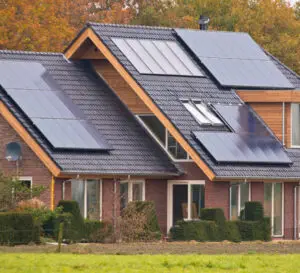by Elisa Wood
 Household investment in energy is on the rise as consumers install more distributed energy resources in their homes, according to the International Energy Agency (IEA). This is one of several good economic signals for distributed energy we’ve picked up in recent reports.
Household investment in energy is on the rise as consumers install more distributed energy resources in their homes, according to the International Energy Agency (IEA). This is one of several good economic signals for distributed energy we’ve picked up in recent reports.
The IEA report, “Who is investing in energy around the world, and who is financing it?” finds that household share of energy investment has doubled since 2015 — largely due to those with higher incomes adopting rooftop solar, energy efficiency improvements, heat pumps, and electric vehicles.
That’s pushed household investment up to 18%, with governments and private enterprises making up the rest.
At 11% North America has some catching up to do compared to other advanced economies, such as Japan and Korea (29%) and Europe (27%).
US performance may improve as government money flows into distributed energy from the Investment and Jobs Act (IIJA) and the Inflation Reduction Act (IRA). A separate peer-reviewed report from the IEA evaluating US energy goals finds that the two laws are making the US a major market for renewables, batteries and electric vehicles and significantly boosting energy efficiency.
Local solar tops big solar in NY
New York, in particular, stands out as a model. Distributed solar deployment is now outpacing utility-scale renewables, averaging 31% annual growth over the last decade. This growth has created 5.7 GW of distributed solar, including nearly 1 GW in 2023 alone, according to a report by the New York Solar Energy Industries Association.
Much of the growth is driven by community solar, an option for apartment dwellers and others who cannot install rooftop solar.
“While utility-scale renewables have struggled under the pressure of economic and supply chain challenges in recent years, New York’s distributed solar industry has proven it is nimble and can successfully deploy projects at scale despite facing similar headwinds,” NYSEIA wrote. “Conventional wisdom is that utility-scale solar can be deployed faster and cheaper than rooftop and community solar, however, New York has flipped that logic on its head; 93% of New York’s installed solar capacity is rooftop and community solar.”
The state is ahead of schedule in its goal of 10 GW of rooftop and community solar by 2030. As a result, the organization is calling on state lawmakers to raise the state’s distributed solar goal to 20 GW by 2035. NYSEIA says the additional 10 GW will save:
- $50 billion in gross utility bill savings for New York households and businesses
- $3.6 billion in direct financial benefit to host communities, including $1.8 billion in revenue to rural landowners and $1.8B in tax revenue to local governments and school districts.
To reach 20 GW of distributed solar by 2035, the state will need to sustain just 7-10% annual growth in deployment.
Leave a Reply